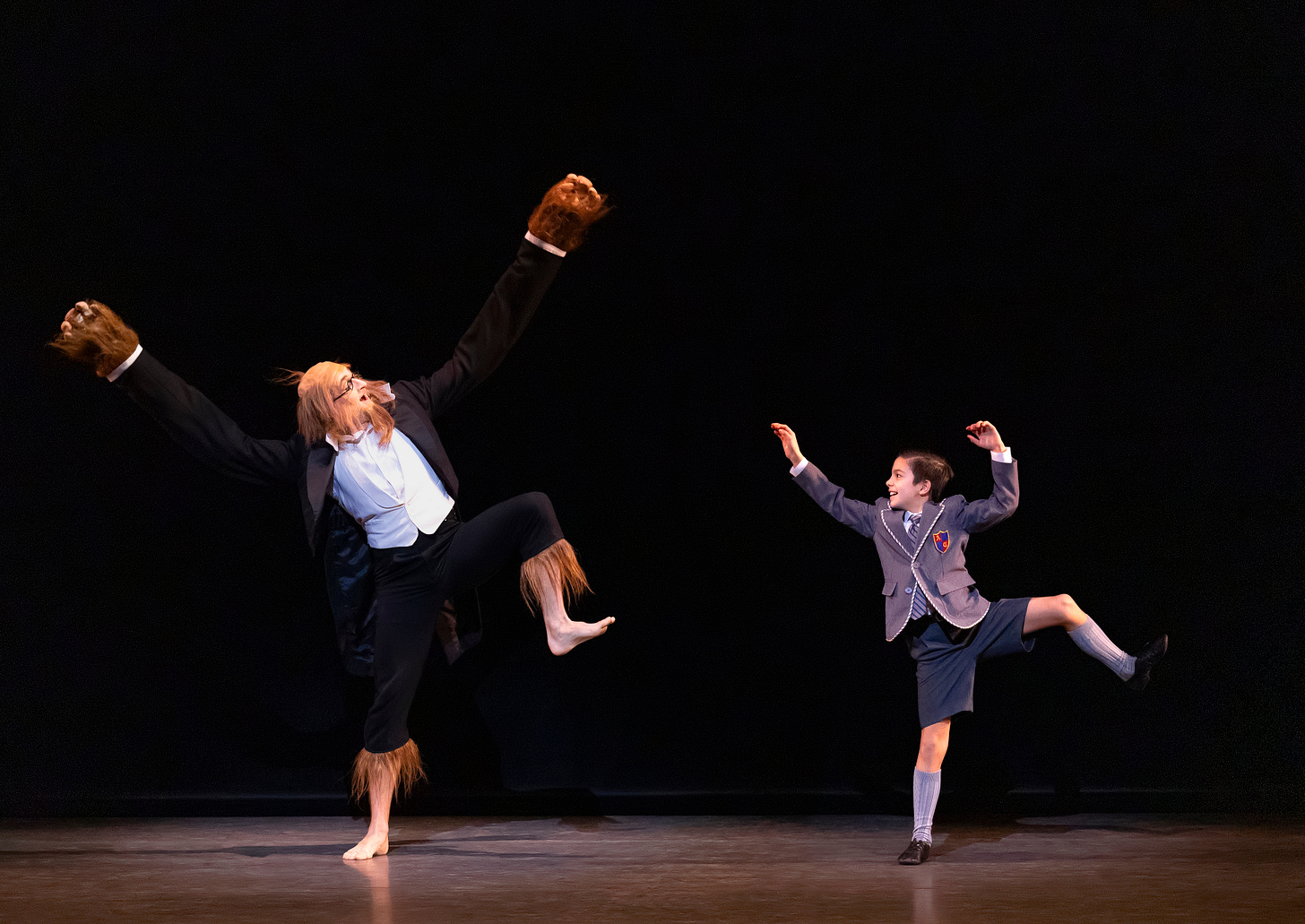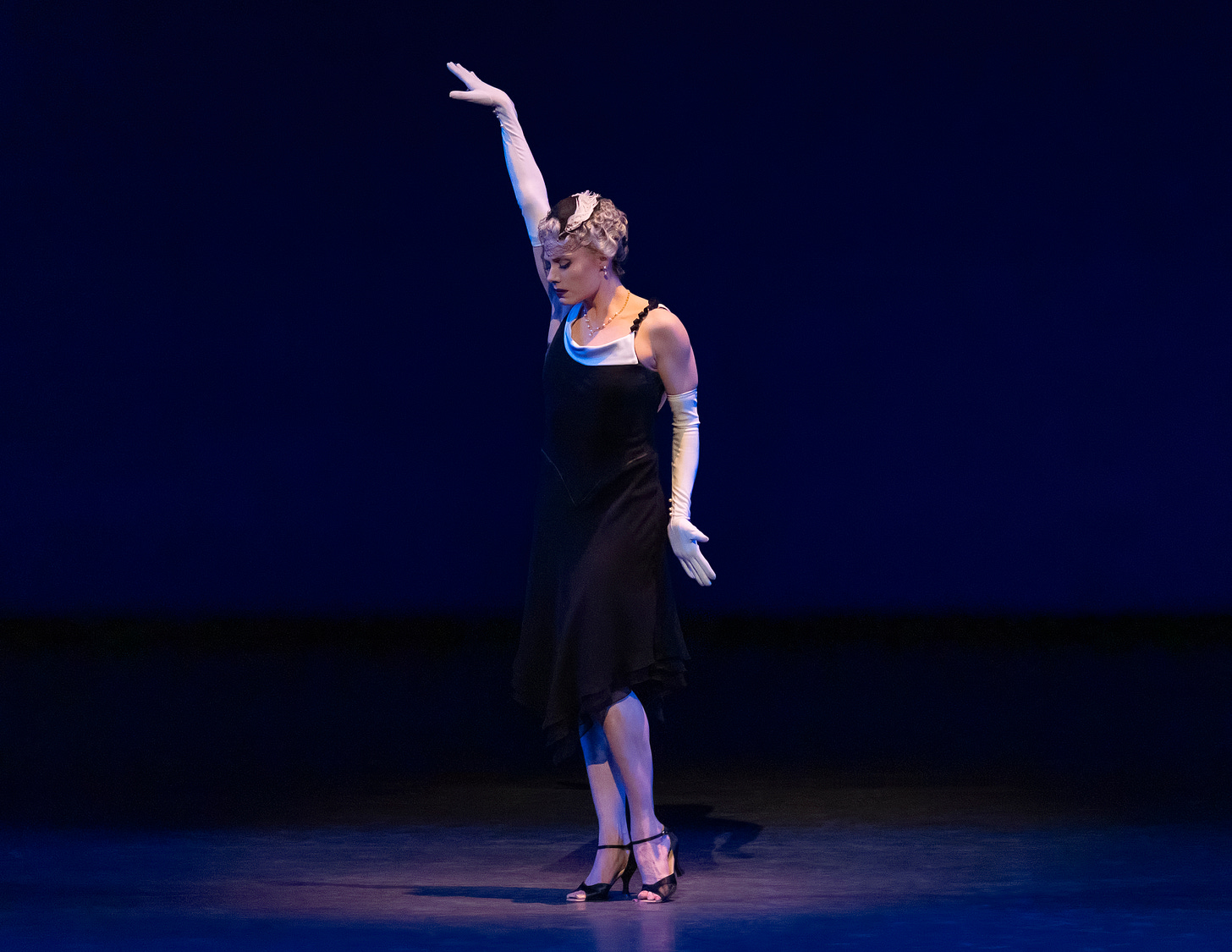The full cast Christopher Wheeldon’s “Carnival of the Animals” at New York City Ballet. Photo by Erin Baiano.
In the final week of its winter season, New York City Ballet introduced a program of lighter works, to attract families with kids. It’s a good idea, in principle. I just wish there were more ballets made with kids in mind; it’s a neglected corner of ballet. We can’t expect “Nutcracker” to do all the work. Only one of the ballets here, Christopher Wheeldon’s “Carnival of the Animals,” was made expressly with kids in mind, and includes an actual child, from the School of American Ballet, always a treat. The others, all by Balanchine, were simply upbeat, or brief, or both: “Stars and Stripes,” “Tarantella,” and “Tchaikovsky Pas de Deux. A bit of a mish-mash.
It's odd to see “Stars and Stripes” open a program in the dead of winter, with no celebratory purpose. Still, it’s a jolly piece. Some find “Stars and Stripes,” Balanchine’s 1958 pseudo-patriotic ballet to Sousa (as orchestrated by Hershy Kay), irritatingly gung-ho, but I’m always delighted by its cheekiness. It conveys the opposite of sentimental nationalism. In fact, I suspect some patriots might be offended by its flippancy. The ladies prance with trumpets or batons in hand, feathers in their caps, high-stepping and kicking their legs or popping into the air like popcorn. Everyone seems to salute every five seconds. One of the leads (Ashley Hod) executes a series of gargouillades, tracing little circles with her feet in the air, all while pretending to play the trumpet. The men turn like tops and do cabrioles every which way, mixing in a few mazurka steps. They look more like tin soldiers than like real ones. Hershy Kay’s orchestration is full of twinkly bell sounds and piccolos. The grand finale brings out the full cast, like the end of “Sleeping Beauty.”
Harrison Coll as the baboon and Hannon Hatchett as the boy in Wheeldon’s “Carnival of the Animals.” Photo by Erin Baiano.
Fun as this all can be, casting matters. Hod was light on her toes as the leader of the second “regiment,” but in the first, Erica Pereira was unmusical and failed to show even the most basic baton skills. KJ Takahashi led the men’s regiment with gusto and clean beats, but in the final pas de deux, danced by Megan Fairchild and Joseph Gordon, the partnering was stiff and a little wobbly. Fairchild had an off night—she looked tense. And even though Gordon danced beautifully, and did a series of fantastic turns à la seconde (including a few triples!), it’s hard not to feel that he is temperamentally unsuited to the role of the blustering “El Capitán.” He’s supposed to be a ridiculous, puffed-up showoff, not a danseur noble.
Casting issues affected “Tarantella” and “Tchaikovsky Pas de Deux” as well. In the former, Emma Von Enck, a bright, immensely capable dancer, seemed so eager to hit all the right notes that she was consistently a touch ahead of the beat. She lacked ease, a major ingredient of charm. In contrast her partner, Daniel Ulbricht, danced his role with maximum efficiency, each joke and effect planned and polished to a high gleam. “Tchaikovsky Pas de Deux,” another crowd-pleaser, was danced by Unity Phelan (replacing Tiler Peck) and Roman Mejía. The woman’s role requires wit and accent—after all, it was made for Violette Verdy, who had both qualities in great abundance. Phelan is too tasteful, too easy-going, too lyrical. All wonderful qualities, but wrong for this ballet. It’s not “Flower Festival in Genzano.”
Wheeldon’s “Carnival of the Animals” has not been seen here since 2013. It was made a decade earlier, just two years after Wheeldon became choreographer in residence at the company. John Lithgow was invited to compose a narrative frame for the clever suite, which Camille Saint-Saëns originally composed to be played on two pianos, among friends. The rhyming text, narrated onstage, recounts the story of a young boy, Oliver, who, while touring the Natural History Museum with his classmates, falls asleep under a bench and wakes up among the animals in the exhibits. The twist is that the animals all take on the qualities of people in his life. The weasels and rats are his classmates, the tortoises are two elderly twins he sees in Central Park, the Kangaroo is the school librarian (who later also becomes a mermaid).
The conceit is sweet, and on March 1 the boy was played with aplomb and winning simplicity by Hannon Hatchett, from the School of American Ballet. (Terrence Mann was the narrator, and also became the elephant in one of the numbers.) Each piece is a brief miniature. Most are charming and funny, with one major exception, a despondent mime scene depicting the boy’s worried parents, set to a touching piece for two pianos and clarinet. The hens and cockerels peck, flap their wings, and tap their pointe shoes in a style that nods to the opening of Frederick Ashton’s “La Fille Mal Gardée.” The two tortoises (Janelle Manzi and Mary Elizabeth Sell) slither onto the stage behind umbrella-shells, sticking their necks out to sniff the air, and then fold and unfold their legs in a slow-motion version of the can-can (the music is a comically slow rendition of Offenbach’s “galop infernal”). Phelan is a kindly librarian, who, after handing her book to Oliver, punches at the air with her paw-shaped mitts. Harrison Coll’s baboon does cartwheels with his extra-long arms while Oliver hammers away at his scales on the piano. Each piece contains a single idea.
Sara Mearns as the former ballerina in Wheeldon’s “Carnival of the Animals.” Photo by Erin Baiano.
The most original number is perhaps the Swan, set to the familiar melody for piano and cello that Michel Fokine used for his “Dying Swan.” Instead of a bird, Wheeldon has conjured up a former ballerina remembering her glory days. Here, the casting was perfect. Sara Mearns, the company’s most expressive dancer, moved only her arms and hands, sheathed in long gloves, her back turned to the audience. Her feet, in low heels, were earth-bound. She hid her face, wistfully raising a slender arm, her sense of loss and grandeur expressed through her back and in every trembling finger. The image conjured up not only Anna Pavlova, but also Mearns’s own début in “Swan Lake” as a nineteen-year-old corps de ballet member in 2006.
This “Carnival” is a sweet piece, un-pretentious, ingenious in moments, well-constructed. You can sense that Wheeldon was already beginning to think about how to depict human behavior and build stories. It is his first step toward “Alice in Wonderland,” which he would stage in 2011. Here, his storytelling skills were still in their infancy. As a whole the ballet could use more inventiveness, more movement ideas, a more refined sense of humor. But it’s pleasing and looks like fun to dance, and that’s important too. And it’s a good ballet for kids, who like it when things make sense. Maybe, in the same vein, the company could bring back another charming, story-filled suite that hasn’t been dusted off in a while: Jerome Robbins’s “Ma Mère L’Oye.” I have fond memories.







I really liked this review, especially details about Von Enck and Phelan. I was at this performance, and agree with your comments. It was my first time seeing Von Enck in a leading role. As someone already said below, "ease, a major ingredient of charm" is a great description!
"ease, a major ingredient of charm" is such an excellent line